Simulation and Prediction of the Impact of Climate Change Scenarios on Runoff of Typical Watersheds in Changbai Mountains, China
Abstract
:1. Introduction
2. Materials and Methods
2.1. Study Area
2.2. Data Source and Processing
2.2.1. Geospatial Data
2.2.2. Meteorological and Hydrological Data
2.3. Research Methods
3. Results and Discussion
3.1. HEC-HMS Hydrological Modeling
3.2. Future Runoff Simulation
3.3. Discussion
4. Conclusions
- The HEC-HMS model has good applicability in the Erdao Songhua River Basin of Changbai Mountains. By constructing the HEC-HMS model suitable for the watershed and calibrating the model, the total qualified rate of the daily rainfall runoff simulation in the watershed during the wet season is 75%, and the DC average of the qualified year reaches 0.705. The model can accurately restore hydrological processes in the study area.
- By conducting the analysis of the comparison chart between the simulation and the actual measurement, it can be observed that in the years with better simulation results, such as 2010, 2013 and 2017, the DC value in these years all reached above 0.7, and in 2010, it reached 0.9. The flow changes in these years were relatively gentle, but the peaks were obvious. Statistics on rainfall data found that rainfall in these years was large; it was 688.9 mm in 2010, 652.5 mm in 2013 and 542.3 mm in 2017. During the abundant rainfall period, the river runoff is obviously controlled by the rainfall process. The HEC-HMS hydrological model is mainly driven by precipitation. Thus, the greater the precipitation, the greater the contribution of the surface runoff process to the entire water cycle, and the model’s interpretation of runoff flow is more accurate. For the years 2011, 2012 and 2014 with poor simulation results, the simulated value in June was much smaller than the actual flow value, and runoff fluctuated greatly, resulting in inaccurate overall simulation results for that year. Further analysis of the reasons may be related to the geographical location and topographical conditions of the study area. There are many production processes and forms of surface runoff in this area, including melting of ice and snow, and groundwater discharges to river valley runoff in the form of springs. Therefore, when discussing the water cycle process in this region, especially in dry years and dry seasons, various recharge sources such as precipitation, surface water, groundwater and springs should be comprehensively considered.
- In the next 30 years (2021–2050), under the two climate scenarios of SSP2-4.5 and SSP5-8.5, rainfall in the basin will generally increase, and rainfall will be more evenly distributed in the future. The flow of the basin’s outlet during the wet season in the next 30 years was simulated, and it was found that the SSP2-4.5 and SSP5-8.5 scenarios have decreased by 33.3% and 34.2%, respectively. This may be related to the decrease in rainfall from June to September during the wet season in the next 30 years compared with the historical period.
- Analysis of the simulated future runoff eigenvalues shows that the peak future runoff occurs most in August, accounting for 40% and 46.7% of the two scenarios, respectively, followed by September. Compared with the peak time in the historical period, most of them appeared in July and August, both accounting for 33.3%, indicating that there will be a certain delay in the peak time in the next 30 years. In the next 30 years, the maximum flow rate under the SSP2-4.5 scenario will be 2130.6 m3/s in 2050, and the maximum flow rate under the SSP5-8.5 scenario will be 2340.7 m3/s in 2047.
Author Contributions
Funding
Data Availability Statement
Acknowledgments
Conflicts of Interest
References
- Dong, L.H.; Xiong, L.H.; Yu, K.X. Research progress of climate change and human Activities on hydrology. Adv. Water Sci. 2012, 23, 278–285. (In Chinese) [Google Scholar]
- Chen, S.; Yu, B.; Wu, R.; Chen, W.; Song, L. The dominant North Pacific atmospheric circulation patterns and their relations to Pacific SSTs: Historical simulations and future projections in the IPCC AR6 models. Clim. Dyn. 2021, 56, 701–725. [Google Scholar] [CrossRef]
- Fischer, H.; Broek, K.; Ramisch, K.; Okan, Y. When IPCC graphs can foster or bias understanding: Evidence among decision-makers from governmental and non-governmental institutions. Environ. Res. Lett. 2020, 15, 114041. [Google Scholar] [CrossRef]
- Cao, W.X.; Zhang, Z.Q.; Liu, Y.Q.; Band, L.E.; Wang, S.P.; Xu, H. Seasonal differences in future climate and streamflow variation in a watershed of Northern China. J. Hydrol. Reg. Stud. 2021, 38, 100959. [Google Scholar] [CrossRef]
- Sun, J.Q.; Li, H.Y.; Wang, X.J.; Shahid, S. Water resources response and prediction under climate change in Tao’er River Basin, Northeast China. J. Mt. Sci. 2021, 18, 2635–2645. [Google Scholar] [CrossRef]
- Golmohammadi, G.; Rudra, R.; Prasher, S.; Madani, A.; Mohammadi, K.; Goel, P.; Daggupatti, P. Water Budget in a Tile Drained Watershed under Future Climate Change Using SWATDRAIN Model. Climate 2017, 5, 39. [Google Scholar] [CrossRef] [Green Version]
- Kim, S.; Kim, H.; Kim, K.; Jun, S.M.; Hwang, S.; Kang, M.S. Assessing the Hydroclimatic Movement Under Future Scenarios Including Both Climate and Land Use Changes. Water 2021, 13, 1120. [Google Scholar] [CrossRef]
- Song, P.; Liu, W.; Sun, J.; Wang, C.; Kong, L.; Nong, Z.; Lei, X.; Wang, H. Annual runoff forecasting based on multi-model information fusion and residual error correction in the ganjiang river basin. Water 2020, 12, 2086. [Google Scholar] [CrossRef]
- Yang, M.X. Prediction of annual runoff at the danjiangkou reservoir, china based on forecast domain. Appl. Ecol. Environ. Res. 2019, 17, 9561–9575. [Google Scholar] [CrossRef]
- Liu, Y.; Ye, L.; Qin, H.; Ouyang, S.; Zhang, Z.; Zhou, J. Middle and long-term runoff probabilistic forecasting based on gaussian mixture regression. Water Resour. Manag. 2019, 33, 1785–1799. [Google Scholar] [CrossRef]
- Sun, M.; Kong, X.C.; Geng, W.H. Time series analysis of monthly Precipitation in Shandong Province based on ARIMA Model. J. Ludong Univ. 2013, 29, 244–249. (In Chinese) [Google Scholar]
- Sun, X.T.; Ren, G.H.; Du, K. Monthly rainfall prediction based on grey correlation method. J. Irrig. Drain. 2019, 38, 90–95. (In Chinese) [Google Scholar]
- Yuan, M.; Shen, J.S.; Zhang, Y.; Zhang, R.J.; Zhang, Y.H. Global Temperature Prediction Based on GA-BP Neural Network. J. Zhengzhou Inst. Aeronaut. Ind. Manag. 2020, 38, 67–75. (In Chinese) [Google Scholar]
- Zhou, Y.; Guo, P.; Yang, L. Prediction model of monthly Runoff in wet season based on wavelet analysis. Shaanxi Water Resour. 2019, 10, 37–39+42. (In Chinese) [Google Scholar]
- Sun, D.Y.; Hu, X.Q.; Wang, Z.G.; Lv, H.F. Runoff change and prediction in the Shule River Basin. Water Resour. Plan. Des. 2019, 9, 1–4+118. (In Chinese) [Google Scholar]
- Bao, Z.X.; Zhang, J.Y.; Yan, X.L.; Wang, G.Q.; Jin, J.L.; Liu, Y.; Guan, X.X. Future streamflow assessment in the Haihe River basin located in northern China using a regionalized variable infiltration capacity model based on 18 CMIP5 GCMs. J. Water Clim. Chang. 2020, 11, 1551–1569. [Google Scholar] [CrossRef]
- Jiang, T.; Lu, Y.R.; Huang, J.L.; Wang, Y.J.; Su, B.D. Overview of CMIP6 Model new Scenario (SSP-RCP) and Its Application in Huaihe River Basin. Prog. Meteorol. Sci. Technol. 2020, 10, 102–109. (In Chinese) [Google Scholar]
- Pokhrel, I.; Kalra, A.; Rahaman, M.M.; Thakali, R. Forecasting of Future Flooding and Risk Assessment under CMIP6 Climate Projection in Neuse River, North Carolina. Forecasting 2020, 2, 323–346. [Google Scholar] [CrossRef]
- Wang, L.; Zhai, W.L.; Zhang, J.H.; Cao, H.Q.; Tang, J. Prediction and characteristics of runoff in the upper Han River basin under climate change based on RBF-SWA. J. Chang. Acad. Sci. 2022, 19, 1–8. (In Chinese) [Google Scholar]
- Tang, Z.N.; Yang, G.L.; Liu, P.X. Prediction of Runoff in Lanjiang River Basin Based on HEC-HMS Model. Soil Water Conserv. Bull. 2021, 41, 137–145. (In Chinese) [Google Scholar]
- Zhang, L.; Yang, X.L. Applying a Multi-Model Ensemble Method for Long-Term Runoff Prediction under Climate Change Scenarios for the Yellow River Basin, China. Water 2018, 10, 301. [Google Scholar] [CrossRef] [Green Version]
- Gao, Y.F.; Chen, Y.; Jiang, Y.F.; Peng, T. Effect of DEM data source and resolution on HEC-HMS hydrological modeling. Adv. Water Sci. 2015, 26, 624–630. (In Chinese) [Google Scholar]
- Li, S.; Lai, Z.; Wang, Q.; Wang, Z.; Li, C.; Song, X. Distributed simulation for hydrological process in Plain River network region using SWAT model. Trans. Chin. Soc. Agric. Eng. 2013, 29, 106–112. [Google Scholar]
- Chu, X.; Steinman, A. Event and Continuous Hydrologic Modeling with HEC-HMS. J. Irrig. Drain. Eng. 2009, 135, 119–124. [Google Scholar] [CrossRef]
- Demlie, Z.; Assefa, M. Applicability of a Spatially Semi-Distributed Hydrological Model for Watershed Scale Runoff Estimation in Northwest Ethiopia. Water 2018, 10, 923. [Google Scholar]
- Al-Abed, N.; Abdulla, F.; Khyarah, A.A. GIS-hydrological models for managing water resources in the Zarqa River basin. Environ. Geol. 2005, 47, 405–411. [Google Scholar] [CrossRef]
- Meenu, R.; Rehana, S.; Mujumdar, P.P. Assessment of hydrologic impacts of climate change in Tunga-Bhadra river basin, India with HEC-HMS and SDSM. Hydrol. Processes 2013, 27, 1572–1589. [Google Scholar] [CrossRef]
- Sardoii, E.R.; Rostami, N.; Sigaroudi, S.K.; Taheri, S. Calibration of loss estimation methods in HEC-HMS for simulation of surface runoff (Case Study: Amirkabir Dam Watershed, Iran). Adv. Environ. Biol. 2012, 6, 343–348. [Google Scholar]
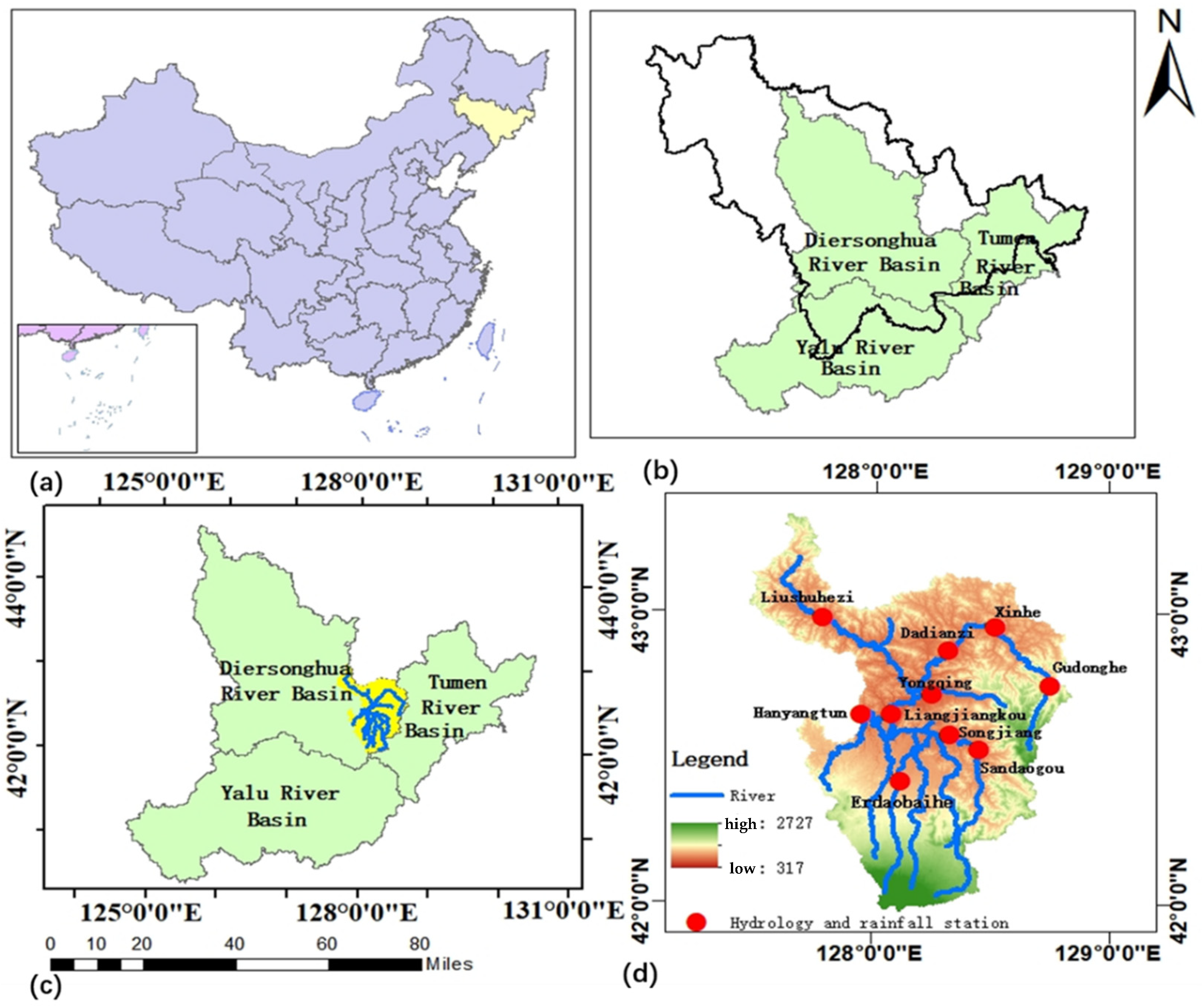
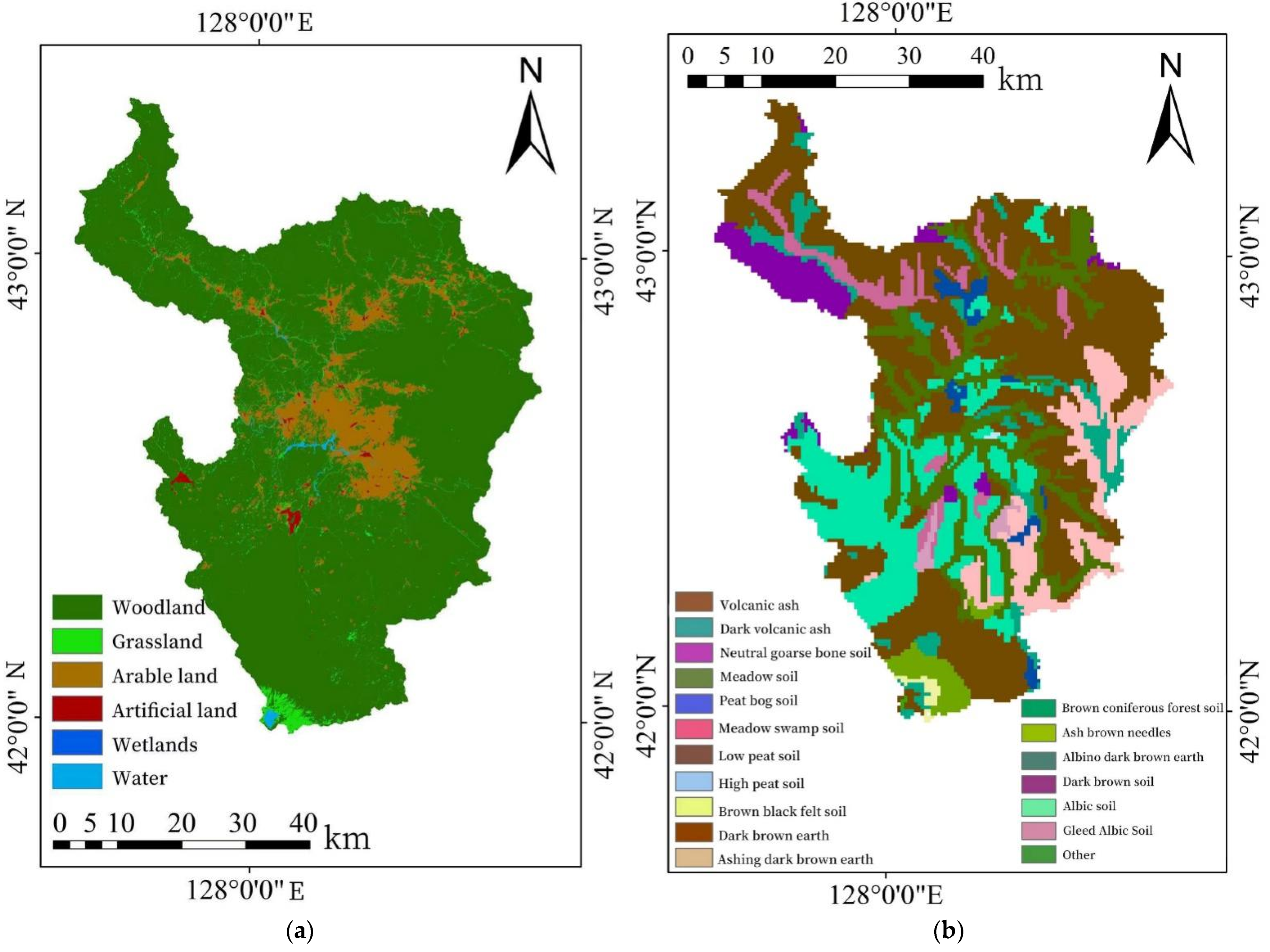
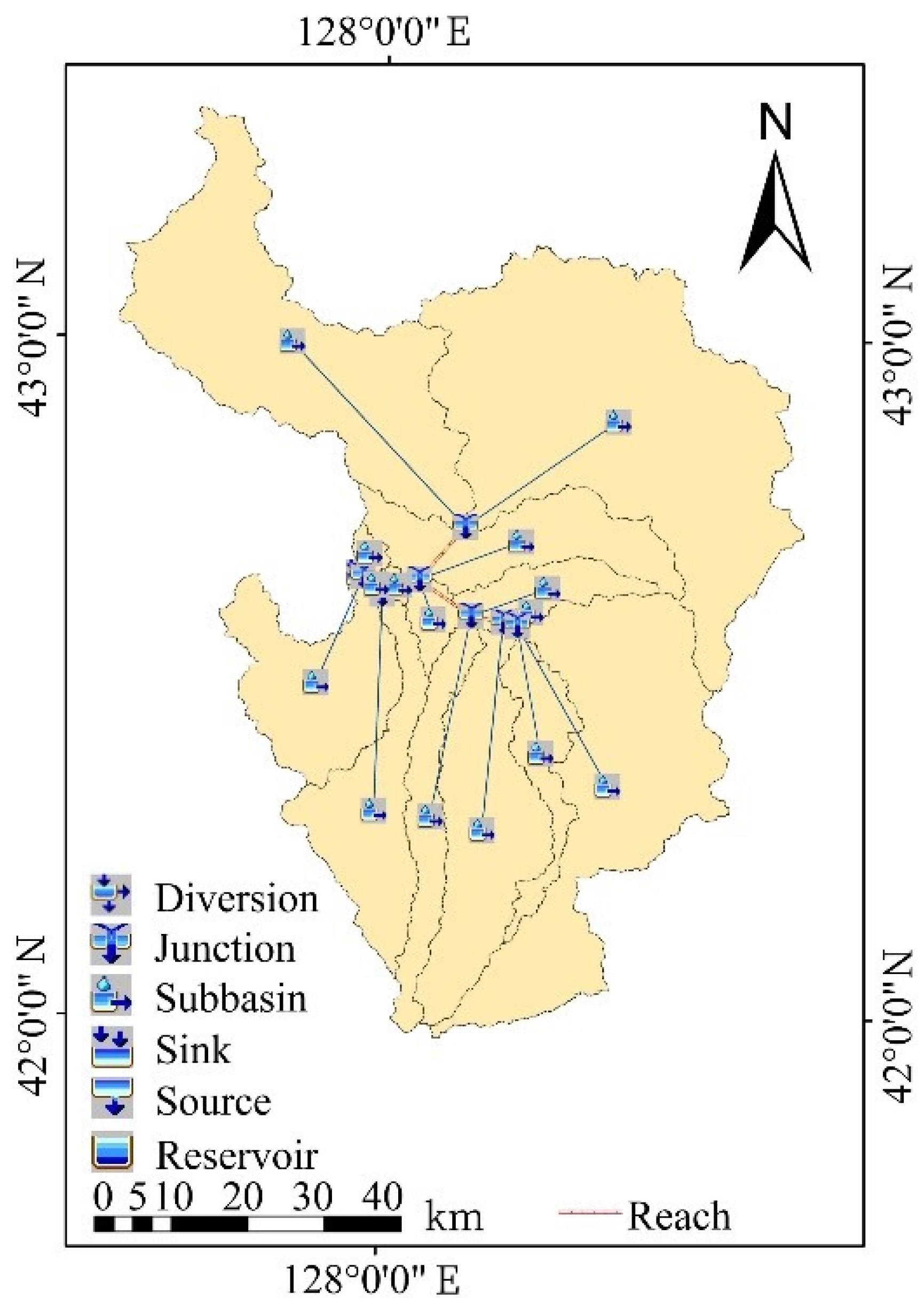


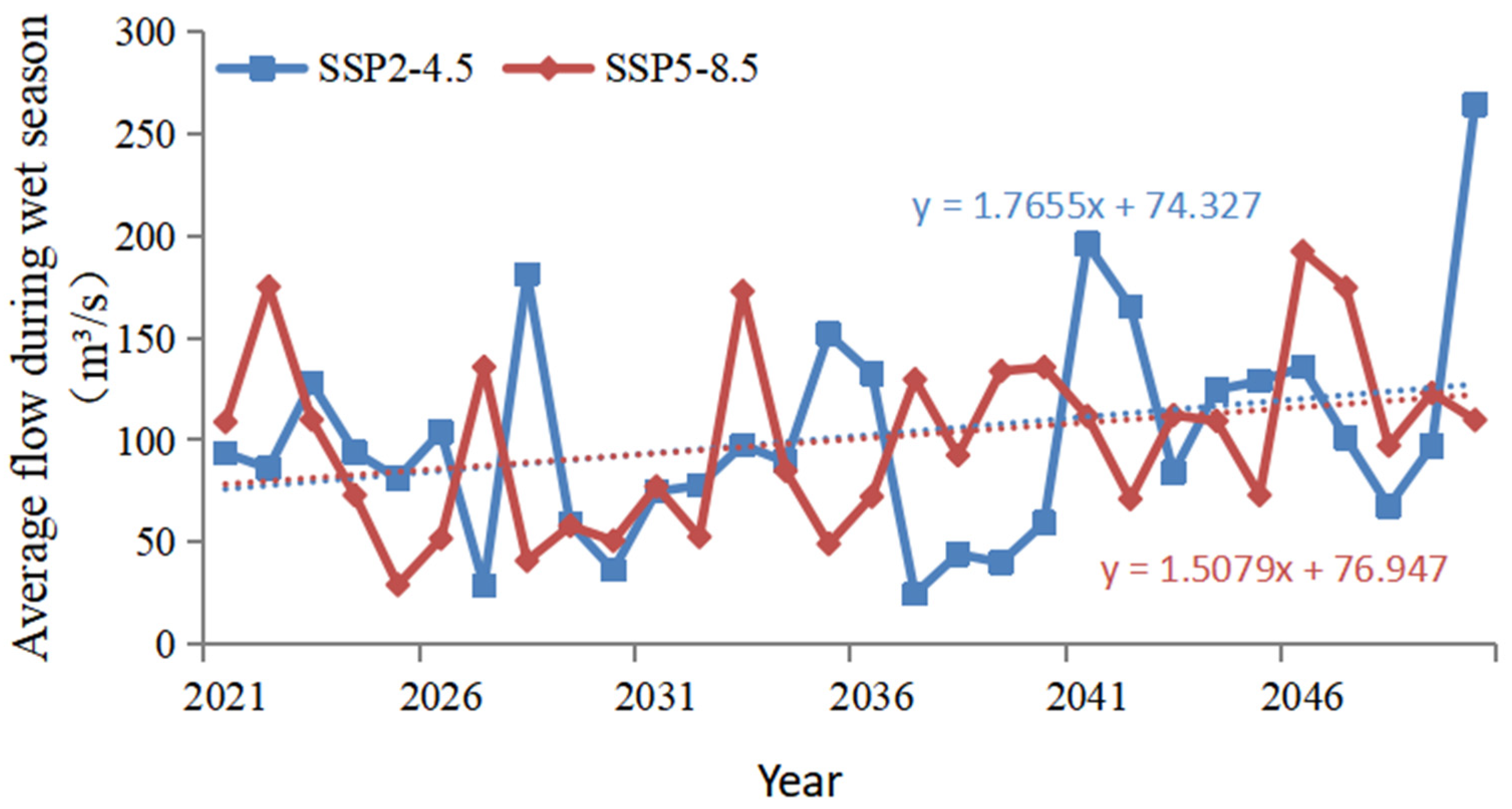
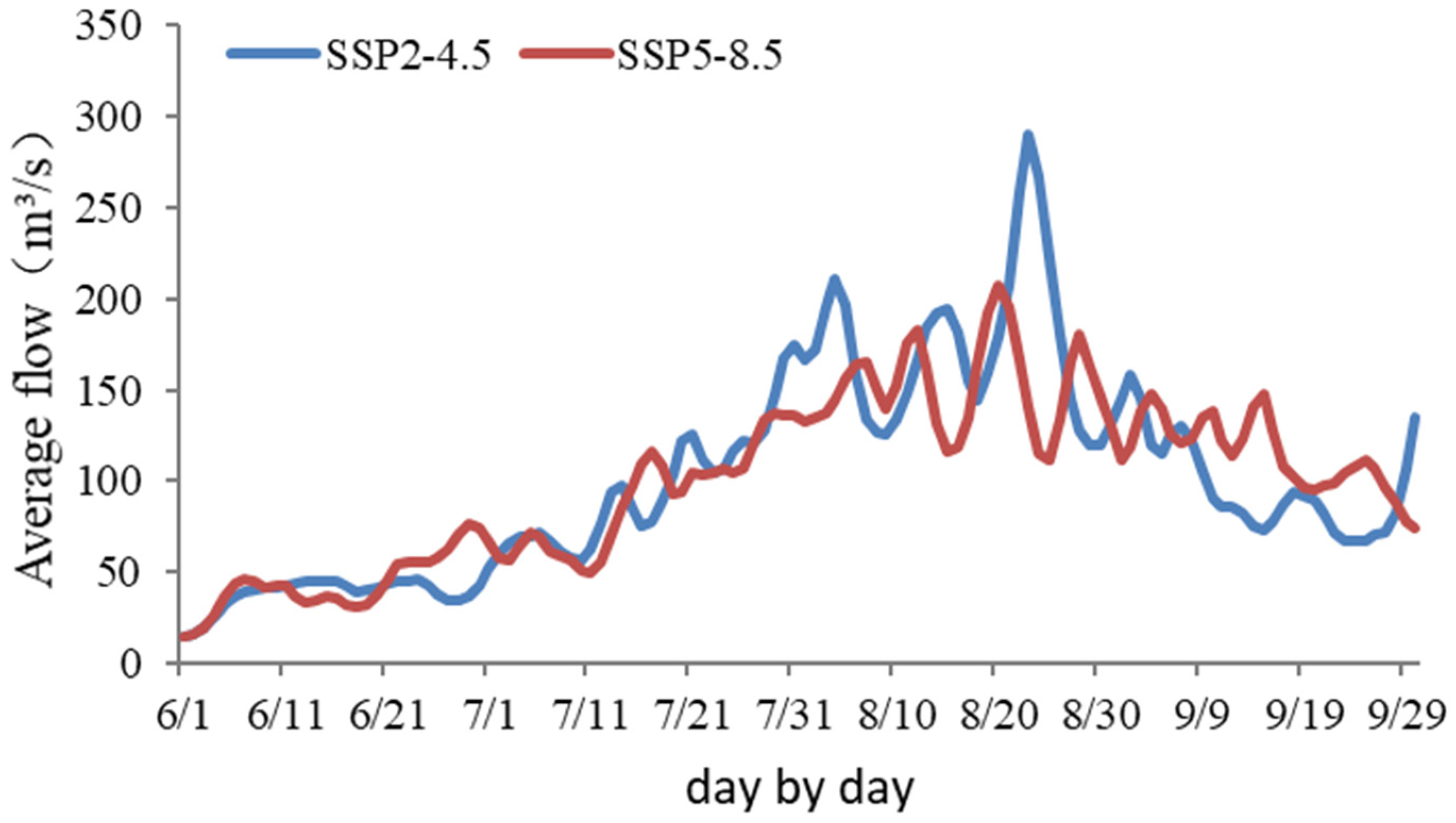
| CN | Impervious | tlag | RC | Ratio | |
|---|---|---|---|---|---|
| W280 | 10 | 8 | 450 | 0.8 | 0.1 |
| W350 | 35 | 8 | 400 | 0.8 | 0.1 |
| W380 | 28 | 8 | 300 | 0.8 | 0.1 |
| W390 | 10 | 8 | 60 | 0.8 | 0.1 |
| W400 | 15 | 8 | 60 | 0.8 | 0.1 |
| W410 | 20 | 8 | 300 | 0.8 | 0.1 |
| W420 | 22 | 8 | 60 | 0.8 | 0.1 |
| W430 | 15 | 8 | 150 | 0.8 | 0.1 |
| W440 | 15 | 8 | 400 | 0.8 | 0.1 |
| W450 | 23 | 8 | 200 | 0.8 | 0.1 |
| W460 | 15 | 8 | 400 | 0.8 | 0.1 |
| W470 | 28 | 8 | 150 | 0.8 | 0.1 |
| W480 | 15 | 8 | 400 | 0.8 | 0.1 |
| W490 | 32 | 8 | 400 | 0.8 | 0.1 |
| W500 | 20 | 8 | 300 | 0.8 | 0.1 |
| R130 | R140 | R150 | R160 | R170 | R180 | R190 | |
|---|---|---|---|---|---|---|---|
| K | 10 | 10 | 10 | 20 | 20 | 30 | 10 |
| X | 0.01 | 0.5 | 0.05 | 0.3 | 0.25 | 0.1 | 0.2 |
| Period | Year | Peak Current Time Difference ( ) | Relative Error of Peak Flow (REp) | Relative Error of Total Flow (REv) | Coefficient of Certainty (DC) | R2 | Whether It Is Passed |
|---|---|---|---|---|---|---|---|
| Rate regulation | 2006 | 0 | 17.8% | −8.2% | 0.710 | 0.763 | yes |
| 2007 | 0 | −5.9% | −4.5% | 0.609 | 0.777 | yes | |
| 2008 | 1 | −4.7% | −9.4% | 0.660 | 0.700 | yes | |
| 2009 | 0 | −8.5% | −19.9% | 0.636 | 0.706 | yes | |
| 2010 | 0 | −4.2% | −4.2% | 0.906 | 0.907 | yes | |
| 2011 | 75 | −8.1% | −17.9% | 0.303 | 0.429 | no | |
| Verification period | 2012 | 1 | 15.0% | −9.8% | 0.288 | 0.521 | no |
| 2013 | 1 | −17.4% | −15.1% | 0.739 | 0.749 | yes | |
| 2014 | 0 | −20.2% | −12.4% | 0.450 | 0.485 | no | |
| 2015 | 1 | −17.0% | 1.2% | 0.603 | 0.639 | yes | |
| 2016 | 0 | −5.7% | 3.6% | 0.720 | 0.824 | yes | |
| 2017 | 0 | −18.5% | 8.9% | 0.760 | 0.774 | yes |
Publisher’s Note: MDPI stays neutral with regard to jurisdictional claims in published maps and institutional affiliations. |
© 2022 by the authors. Licensee MDPI, Basel, Switzerland. This article is an open access article distributed under the terms and conditions of the Creative Commons Attribution (CC BY) license (https://creativecommons.org/licenses/by/4.0/).
Share and Cite
Li, Z.; Cao, Y.; Duan, Y.; Jiang, Z.; Sun, F. Simulation and Prediction of the Impact of Climate Change Scenarios on Runoff of Typical Watersheds in Changbai Mountains, China. Water 2022, 14, 792. https://doi.org/10.3390/w14050792
Li Z, Cao Y, Duan Y, Jiang Z, Sun F. Simulation and Prediction of the Impact of Climate Change Scenarios on Runoff of Typical Watersheds in Changbai Mountains, China. Water. 2022; 14(5):792. https://doi.org/10.3390/w14050792
Chicago/Turabian StyleLi, Zhaoyang, Yidan Cao, Yucong Duan, Zelin Jiang, and Feihu Sun. 2022. "Simulation and Prediction of the Impact of Climate Change Scenarios on Runoff of Typical Watersheds in Changbai Mountains, China" Water 14, no. 5: 792. https://doi.org/10.3390/w14050792
APA StyleLi, Z., Cao, Y., Duan, Y., Jiang, Z., & Sun, F. (2022). Simulation and Prediction of the Impact of Climate Change Scenarios on Runoff of Typical Watersheds in Changbai Mountains, China. Water, 14(5), 792. https://doi.org/10.3390/w14050792





